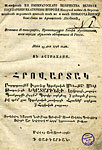Exhibition from the Collections Held at the Manuscripts Department
Russian-Armenian Ecclesiastical Relations is the exhibition organized for the visit of His Holiness Supreme Patriarch and Catholicos of All Armenians
The exhibition Russian-Armenian Ecclesiastical Relations is the result of long-standing cooperation between the Armenian community in St. Petersburg and the National Library of Russia. The collection of ancient Armenian manuscripts and publications in two languages from the library holdings gives an idea of the spiritual life of Armenians dating back to the twelfth century.
None of any other Eastern nation has literature so closely intertwined with the Christian tradition. As the Armenian spiritual leader of St. Petersburg and North-West Ieromonah Nshan said, 'The Church and the book is the foundation of our national existence at all times'.
The exhibition shows equal number of the exhibits in the Russian and Armenian languages, which reflect the history of the two countries, the spread of Armenian literary culture in Russia and prospects for the development of harmonious relations between our countries.
History, according to the renowned Armenian author Raffi, is a spiritual academy, so the first section of the exhibition is devoted to the history of Armenia and its fateful relationship with Russia. Armenians have always sought to acquaint the Russian public with the history of their people. The display includes maps, manuscripts, books on this subject in Armenian and Russian languages. Among them, for example, are the History of Armenia by M. Khorenatsi, St. Petersburg, 1786, the Russian Historical, Geographical, Political and Сivil Lexicon by V. Tatishchev, St. Petersburg, 1793. In addition, you can see the official acts of the Russian Empire issued during the reign of Peter I, Catherine II, Nicholas I and the Collection of Reports Supplementing the History of the Armenian People published in 1833.The exhibition features such contemporary reprints on this subject as The Chronicle of the Рistorical Fortunes of the Armenian People by V. Bryusov, 1989, The Life of Artemy of Ararat, 1980, Iconostasis by Florensky, St. Petersburg, 2010, etc. No wonder that the Armenian community believes that publishing activity contributes to the preservation and development of the spiritual and cultural heritage.
The history of the Armenian Apostolic Church and the materials on its most prominent representatives, who served both for Russia and Armenia, are presented in a separate section. Among them are Joseph Argutinsky, Patriarchs of All Armenians Nerses III and Nerses V, Catholicos of All Armenians Matthew II etc. In this connection, we couldn't resist mentioning the Echmiadzin, as well as the Trinity Monastery of St Sergius and St. Alexander Nevsky Monastery. In particular, a special should be paid to the engraving of 1815 "View of the St. Alexander Nevsky Monastery" by I. Ivanov.
For centuries, the Armenian Apostolic Church has been the only national organization of the Armenian people, providing their ethnic and cultural consolidation, regardless of whether they reside. This is its unique historical role. It have always taken care of poor parishioners, established asylums, as evidenced by the papers shown at the exhibition. These are, mainly, reports of the Armenian-Gregorian churches in Kishinev and Odessa and other cities in Bessarabia and Novorossiya.
Because of the geographic location, one of the few Christian neighbours of Armenia has always been Russia. The interpenetration of cultures is reflected in the next section of the exhibition by such publications as Integrated Primer, Dictionary and some Moral Admonitions. Written and translated from Russian into Armenian and from Armenian into Russian by Cleopatra Sarafova, 1788, Theoretical and Practical Russian Course for Young Armenians by Stepan Nazaryants, 1871, Old Armenian
Reader with Armenian-Russian Dictionary for Beginners by
Russia has become a second home to many Armenians, and they have increased its cultural, scientific and military glory, taken part in the social and economic life. They were given the right to build churches, establish schools and printing enterprises, ie live a full life. Today, Armenians continue to carry the torch of enlightenment. This, in the opinion of the spiritual leader of Armenians of St. Petersburg and the North-West Region Ieromonah Nshan, is the secret of spiritual longevity of the Armenian people.
Of course, the exhibition shows not all items on the subject that are stored in the collections of the National Library of Russia, but the most interesting materials, some of which are exhibited for the first time. Organizers hope that the exposition will excite the desire to consult the books, manuscripts and other materials in the reading rooms of our library.
Member of the Center for Cultural Programs, curator of the exhibition
E.V.Pugina





